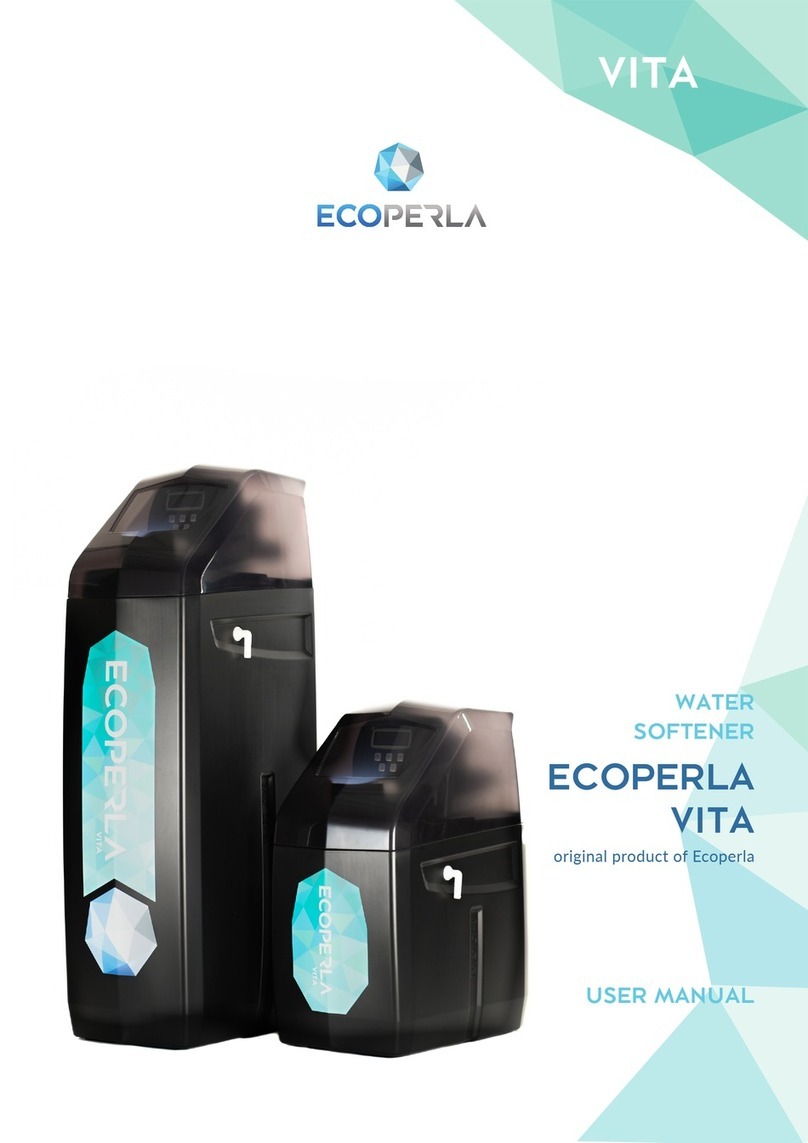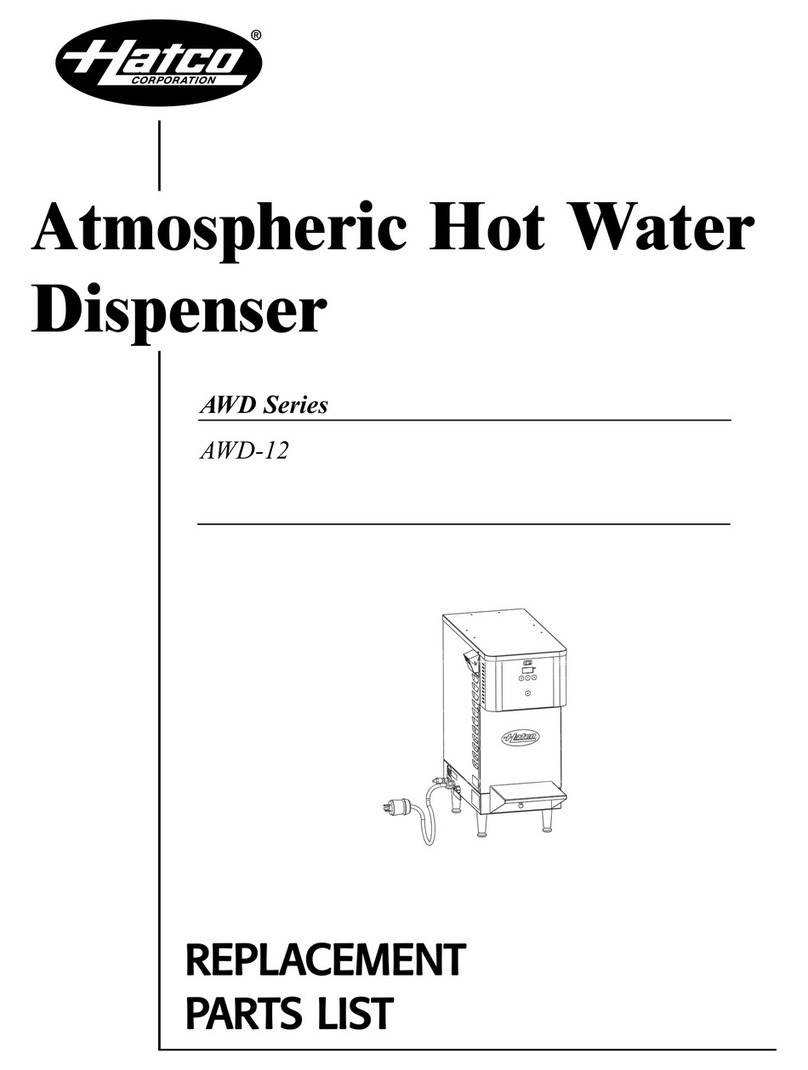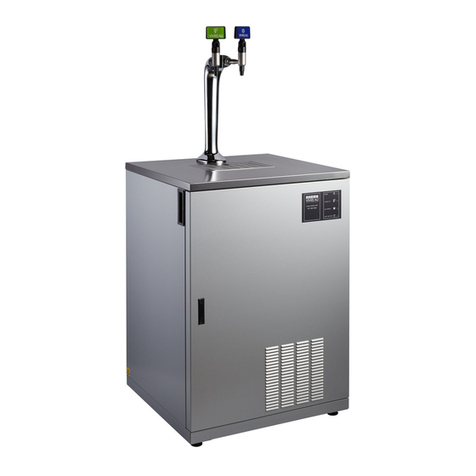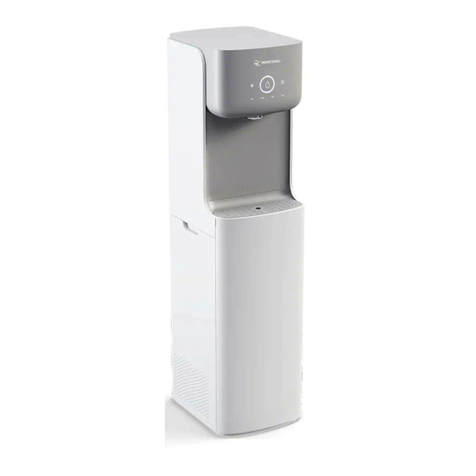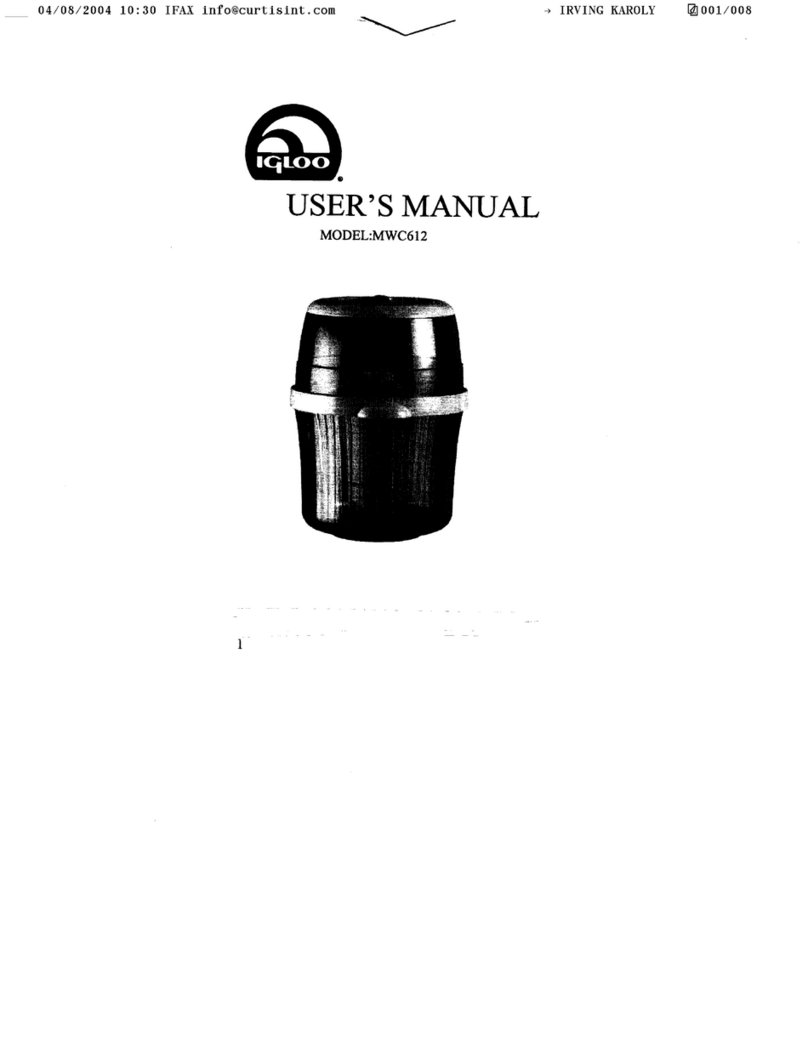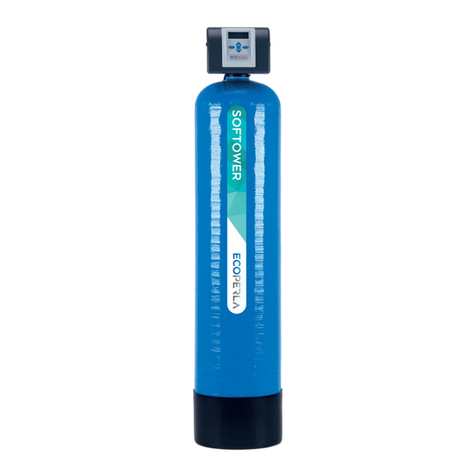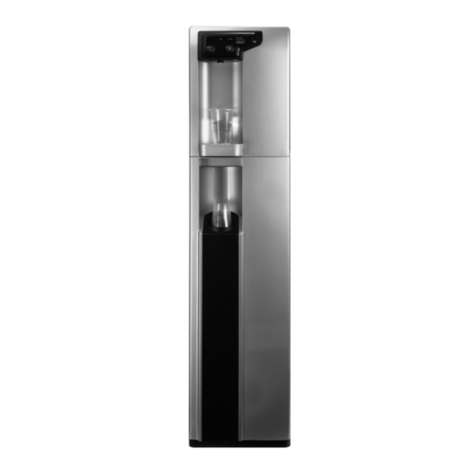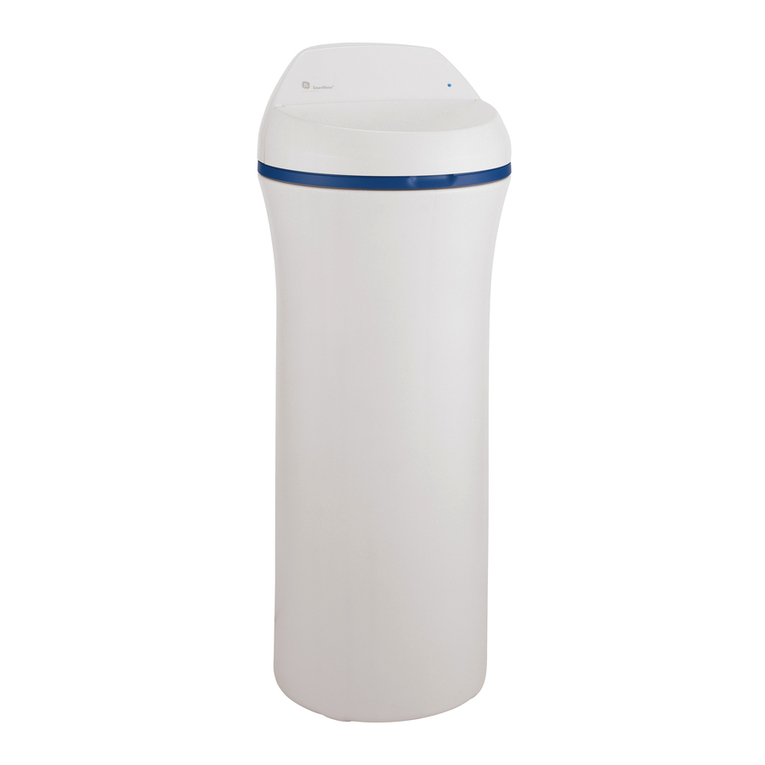Danfoss Akva Vita II TD User manual

Danfoss District Energy
MAKING MODERN LIVING POSSIBLE
Akva Vita II TD & S
Akva Lux II / Akva Les II TD & S
Instructions for installation and use

2
1. Contents
Instructions for installation and use TD & S substations
DKDHR VI.GP.U2.02 Danfoss District Energy
1. Contents................................................................................................................................................................................................................................................2
2. Product introduction, Akva Vita II TD..........................................................................................................................................................................................3
3. Product introduction, Akva Lux II TD / Akva Les II TD ...........................................................................................................................................................4
4. Product introduction, Akva Vita II S ............................................................................................................................................................................................5
5. Product introduction, Akva Lux II S / Akva Les II S .................................................................................................................................................................6
6. Instructions for use, General..........................................................................................................................................................................................................7
7. Instructions for use, Initial adjustment / setting.....................................................................................................................................................................8
8. Installation instructions, Safety and Handling ........................................................................................................................................................................9
9. Installation instructions, GETTING STARTED......................................................................................................................................................................... 10
10. Installation instructions, general............................................................................................................................................................................................... 11
11. Installation instructions - specially for S substations ......................................................................................................................................................... 12
12. Installation instructions - recirculation connection ........................................................................................................................................................... 13
13. Adjustment and commissioning, Akva Vita II TD................................................................................................................................................................. 14
14. Adjustment and commissioning, Akva Lux II TD & Akva Les II TD................................................................................................................................. 15
15. Adjustment and commissioning, Akva Vita II S.................................................................................................................................................................... 16
16. Adjustment and commissioning, Akva Lux II S & Akva Les II S....................................................................................................................................... 17
17. Adjustment and commissioning of S substations, heating circuit................................................................................................................................ 18
18. Operation and maintenance....................................................................................................................................................................................................... 20
19 Troubleshooting.............................................................................................................................................................................................................................. 22
20. EU Declaration of Conformity..................................................................................................................................................................................................... 24
21. Commissioning certicate........................................................................................................................................................................................................... 25
Akva Vita II TD Akva Lux II TD
Akva Les II TD
Akva Vita II S Akva Lux II S
Akva Les II S

1 2 3 4 5 6
Top view
Wall
550
32580
520
25
44
310
45 65 65 65130100
Plate heat exchanger, domestic hot water, type Danfoss XB06H-1
Dierential pressure controller, Danfoss AVPL 0.1–0.25 bar
Dirt strainer, REDAN, embedded in T-piece
Non-return valve
Ball valve
Safety valve, domestic hot water, 10 bar
Thermometer
Pressure outlet 1/2"
HE
SUPPLY
HE
RETURN
Sensor pocket
Fitting piece for meter 3/4" x 110 x 165 mm
DHW controller, PM2+P
Danfoss FJVR for by-pass/circulation
DHW
DCW
DH.
RETURN
DH.
SUPPLY
(By-pass)
(factory connection)
33
Instructions for installation and use TD & S substations
Danfoss District Energy VI.GP.U2.02 DKDHR
2. Product introduction, Akva Vita II TD
Principal components
1.
2.
3.
4.
5.
6.
7.
8.
9.
13.
F.
C.
Plate heat exchanger, brazed, domestic hot water
Domestic hot water controller PM2+P
Bypass thermostat, Danfoss FJVR
Dierential pressure controller, AVPL
Safety valve
Fitting piece for meter
Thermometer, DHW
Dirt strainer
Sensor pocket
White-painted cover
Filter on cold water supply
The unit has been prepared for recirculation.
Fitting set for recirculation connection available as extra equip
ment
Standard item number
Akva Vita II TD H04.393.001
Akva Vita II TD with cover H04.393.001K
Accessories available as extra equipment (mounting on site)
Recirculation pipe set - VVS no. 374976.810
For systems that feature DHW recirculation.
Danfoss Expansion Unit - VVS no. 374972.820.
The expansion unit is available as extra equipment for
systemswhere a oor drain is to be avoided.
(Must not be used in systems with domestic hot water recirculation).
Booster set/pressure intensier - VVS no. 374994.820.
The booster set can be connected as extra equipment in
areaswith low district heating dierential pressure.
1”Fitting set for meter (max. 130 mm) - VVS no. 374929.918
For meters with 1”connectors.
1
6
6
5
4
3
2
8
8
7
9
9
F
13C

535
618
55
325
284
481
72,5
285
37,5 100 130 65 65 65
44
54
138
206
333
535
535
618
32572,5
55
285
37,5 100 130 65 65 65
44
13C
2 Plate heat exchanger, domestic hot water, type Danfoss XB06H-1
4 Differential pressure controller, Danfoss AVPL 0.1–0.25 bar
5 Dirt strainer, REDAN, embedded in T-piece
6 Non-return valve
7 Ball valve
12 Safety valve, domestic hot water 10 bar
13 Thermometer
14 Pressure outlet 1/2"
23 Sensor pocket
24 Fitting piece for meter, 3/4" x 110/165 mm
38 Domestic hot water controller, Danfoss PTC2 + P 3,0
40 Danfoss FJVR for by-pass/circulation
------------------------------
61 Circulation pipe (not part of the delivery)
62 Non-return valve (not part of the delivery)
64 Pump, DHW recirc. (not part of the delivery)
HE
RETURN
HE
SUPPLY
(factory connection)
DHW
DCW
DH.
RETURN
DH.
SUPPLY
DHW
RECIRC
4
Instructions for installation and use TD & S substations
DKDHR VI.GP.U2.02 Danfoss District Energy
3. Product introduction, Akva Lux II TD / Akva Les II TD
Principal components
1.
2.
3.
4.
5.
6.
7.
8.
9.
13.
F.
C.
Plate heat exchanger, brazed, domestic hot water
Domestic hot water controller, PTC2+P
Bypass thermostat, Danfoss FJVR
Dierential pressure controller, AVPL
Safety valve
Fitting piece for meter
Thermometer, hot water
Dirt strainer
Sensor pocket
White-painted cover
Filter on cold water supply
The unit has been prepared for recirculation.
Fitting set for recirculation connection is available as
extraequipment.
Standard item number
Akva Lux II TD 26 H05.393.001
Akva Lux II TD 26 with cover H05.393.001K
Akva Lux II TD 40 H05.393.002
Akva Lux II TD 40 with cover H05.393.002K
Akva Les II TD 60+ H05.393.006
Akva Les II TD 60+ with cover H05.393.006K
Accessories available as extra equipment (mounting on site)
Recirculation pipe set - VVS no. 374976.810
For systems that feature domestic hot water recirculation.
Danfoss Expansion Unit - VVS no. 374972.820.
The expansion unit is available as extra equipment for systems
where a oor drain is to be avoided.
(Must not be used in systems with domestic hot water
recirculation).
Booster set/pressure intensier - VVS no. 374994.820.
The booster set can be connected as extra equipment in areas
with low district heating dierential pressure.
1”Fitting set for meter (max. 130 mm) - VVS no. 374929.918
For meters with 1”connectors.
1
6
6
5
4
3
2
8
8
7
9
9
F

1 2 3 4 5 6
Top view
550
32580
520
25
44
310
45 65 65 65130100
54
138
218.5
340.5
451 254
8
7
1
6
6
5
43
2
8
8
7
9
F
13
9
12
11
10
K
55
Instructions for installation and use TD & S substations
Danfoss District Energy VI.GP.U2.02 DKDHR
4. Product introduction, Akva Vita II S
RADIATOR
HE SUPPLY
FLOOR
HE SUPPLY
FLOOR
HE RETURN
RADIATOR
HE RETURN
(factory connection)
DHW
DCW
DH.
RETURN
DH.
SUPPLY
2 Plate heat exchanger, domestic hot water, type Danfoss XB06H-1
4 Differential pressure controller, Danfoss AVPL 0.1-0.25 bar
5 Dirt strainer, REDAN, embedded in T-piece
6 Non-return valve
7 Ball valve
8 Pump, Wilo Smart 15/6 -130 230V or Grundfos Alpha2 L
12 Safety valve, domestic hot water 10 bar
13 Thermometer
14 Pressure outlet 1/2"
17 Air vent
23 Sensor pocket
24 Fitting piece for meter, 3/4" x 110/165 mm
30 Redan Thermostat, kvs 1.2
38 Domestic hot water controller, PM2+P
40 Danfoss FJVR for by-pass/circulation
43 Blind plate
Principal components
1.
2.
3.
4.
5.
6.
7.
8.
9.
10.
11.
12.
13.
F.
K.
C.
Plate heat exchanger, brazed, domestic hot water
Domestic hot water controller PM2+P
Bypass thermostat, Danfoss FJVR
Dierential pressure controller, AVPL
Safety valve
Fitting piece for meter
Thermometer, ‹oor heating, › thermometer, domestic hot water
Dirt strainer
Sensor pocket
Pump, Wilo Yonos PARA
Thermostat
Air valve
White-painted cover
Filter on cold water supply
Non-return valve - insert
The substation has been prepared for recirculation.
Fitting set for recirculation connection is available as extra
Standard item number
Akva Vita II S A14.393.001
Akva Vita II S with cover A14.393.001K
Accessories available as extra equipment (mounting on site)
Recirculation pipe set - VVS no. 374976.810
For systems that feature domestic hot water recirculation.
Danfoss Expansion Unit - VVS no. 374972.820.
The expansion unit is available as extra equipment for systems
where a oor drain is to be avoided.
(Must not be used in systems with domestic hot water recirculation).
Booster set/pressure intensier - VVS no. 374976.850.
The booster set can be connected as extra equipment in areas
with low district heating dierential pressure.
1”Fitting set for meter (max. 130 mm) - VVS no. 374929.918
For meters with 1”connectors.
C

13
DHW
DHW
CIRC
DCW
DH.
RETURN
DH
SUPPLY
RADIATOR
HE SUPPLY
RADIATOR
HE RETURN
FLOOR
HE SUPPLY
FLOOR
HE RETURN
Plate heat exchanger, domestic hot water, type Danfoss XB06H-1
Dierential pressure controller, Danfoss AVPL 0.1-0.25 bar
Dirt strainer, REDAN, embedded in T-piece
Non-return valve
Ball valve
Pump, Grundfos Alpha2 L 15–60 130 230V
Safety valve, domestic hot water 10 bar
Thermometer
Pressure outlet 1/2"
Air vent
Sensor pocket
Fitting piece for meter, 3/4" x 110/165 mm
Redan Thermostat, kvs 1.2
Domestic hot water controller, Danfoss PTC2 + P 3,0
Danfoss FJVR for by-pass/circulation
Blind plate
Circulation pipe (not part of the delivery)
Non-return valve (not part of the delivery)
Pump, DHW recirc. (not part of the delivery)
(By-pass)
(factory connection)
C
535
618
55
325
284
481
72,5
285
37,5 100 130 65 65 65
44
54
138
206
333
535
535
618
32572,5
55
285
37,5 100 130 65 65 65
44
1
6
6
5
43
2
8
8
7
9
F
9
12
11
10
K
6
Instructions for installation and use TD & S substations
DKDHR VI.GP.U2.02 Danfoss District Energy
5. Product introduction, Akva Lux II S / Akva Les II S
Principal components
1.
2.
3.
4.
5.
6.
7.
8.
9.
10.
11.
12.
13.
F.
K.
C.
Plate heat exchanger, soldered, domestic hot water
Domestic hot water controller, PTC2+P
Bypass thermostat, Danfoss FJVR
Dierential pressure controller, AVPL
Safety valve
Fitting piece for meter
Thermometer, ‹oor heating, › thermometer, domestic hot water
Dirt strainer
Sensor pocket
Pump – Grundfos Alpha2
Thermostat
Air valve
White-painted cover
Filter on domestic cold water supply
Non- return valve, insert
The substation has been prepared for recirculation.
Fitting set for recirculation connection is available as extra
equipment.
Standard item number
Akva Lux II S 26 A15.393.001
Akva Lux II S 26 with cover A15.393.001K
Akva Lux II S 40 A15.393.002
Akva Lux II S 40 with cover A15.393.002K
Akva Les II S 60+ H05.393.006
Akva Les II S 60+ with cover H05.393.006K
Accessories available as extra equipment (mounting on site)
Recirculation pipe set - VVS no. 374976.810
For systems that feature domestic hot water recirculation.
Danfoss Expansion unit - VVS no. 374972.820.
The expansion unit is available as extra equipment for systems
where a oor drain is to be avoided.
(Must not be used in systems with domestic hot water recirculation).
Booster set/pressure intensier - VVS no. 374976.850.
The booster set can be connected as extra equipment in areas with
low district heating dierential pressure.
1”Fitting set for meter (max. 130 mm) - VVS no. 374929.918
For meters with 1”connectors.

77
Instructions for installation and use TD & S substations
Danfoss District Energy VI.GP.U2.02 DKDHR
6. Enduser instructions, General
Instructions
Please read these instructions carefully before installing and commis-
sioning this substation.The manufacturer accepts no liability for loss
or damage resulting from failure to comply with these instructions
for use. Read and follow these instructions carefully to prevent the
risk of physical injury and/or damage to property. Exceeding the
recommended operating parameters appreciably increases the risk
of personal injury and/or damage to property.
Installation, commissioning and maintenance must be carried out
by qualied and authorised personnel (both plumbing and electri-
cal work).
Once the station has been installed and is operating, there is nor-
mally no need to alter the settings or other functions. The district
heating substation is very reliable and easy to operate.
If necessary, you can change the temperature settings as described
on page 8. For more detailed information about the substation,
see the sections concerning installation and commissioning.
Description
These instructions apply to two substation types (TD and S) – which
are both tted with an instantaneous water heater and designed for
direct connection to the district heating supply.
TD substations are tted with a dierential pressure controller that
maintains a constant pressure in the radiators. The supply tempera-
ture to the radiators is always identical to the district heating supply
temperature. The room temperature is adjusted solely using the
radiator thermostats.
S substations are tted with a dierential pressure controller that
maintains a constant pressure in the heating circuit(s). The supply
temperature to the oor heating is regulated using the thermostat
in the substation. S substations are also tted with a pump.
In rooms with oor heating, the temperature is regulated using the
oor heating thermostat for the room in question. In rooms with ra-
diators, the temperature is regulated using the radiator thermostats.
Alternatively, the heating circuits can be regulated using fully auto-
matic Danfoss ECL weather compensation equipment (not standard).
We recommend regular inspections of the substation - ideally in
connection with readings of the district heating meter.
Pay special attention to any leaks and an excessively high return
temperature in the district heating circuit (poor cooling of the district
heating water). Cooling – i.e. the dierence between the supply and
return temperature of the district heating water – has a signicant
eect on the overall energy economy. Therefore, it is important to
focus on the supply and return temperature in the heating system.
The dierence should typically be 30–35°C in systems that operate
with radiators. In systems that feature oor heating, the dierence
is typically 5–10°C. In these systems, it is important that the supply
temperature does not exceed 35°C.
Please note that a low district heating return temperature is directly
dependent on the return temperature from the heating/oor heating
circuit and the return temperature of the domestic hot water recircula-
tion (in systems with domestic hot water recirculation). It is therefore
important to focus on these return temperatures.
Warning! Hot surfaces
Parts of the substation may be very hot and can cause burn in-
juries. Be very careful when you are in the immediate vicinity of
the unit.
Warnings about high pressure and high temperature
The maximum supply temperature in the district heating net-
work can be up to 120°C and the operating pressure can be up
to 16 bar. This may result in a risk of scalding from touching the
substation and from outow of the medium (water/steam). Ex-
ceeding the substation design data and operating parameters for
pressure and temperature carries an appreciable risk of personal
injury and/or damage to property.
Emergencies
In the event of re, leaks or other hazards, immediately shut o
all sources of energy to the substation, if possible, and call for
appropriate assistance.
If the domestic hot water is discoloured or malodorous, shut o
all ball valves on the substation notify all users and call for profes-
sional assistance without delay.
Cooling from the water heater alone:
During tapping, the level of cooling will typically be 30–35°C. When
domestic hot water is not being tapped, it is completely normal for the
return temperature from the water heater to rise slightly. In this situa-
tion, the district heating meter will register very modest consumption
as the volume of water is very small.
On substations with recirculation, the calorie meter registers the heat
loss in the recirculation pipe.
Irregularities
When reading the meter, check all joints and connections for leaks.
If you identify any irregularities/leaks, contact your professional
provider for assistance.
Check the troubleshooting section before contacting your
professional provider.

pin
8
Instructions for installation and use TD & S substations
DKDHR VI.GP.U2.02 Danfoss District Energy
7. Enduser instructions, Initial adjustment/setting
Domestic hot water control
Danfoss PM2+P controller (Fig. 1) for domestic hot water. Set the DHW
temperature by turning the adjuster lever towards red (hotter) or blue
(colder). Start by turning the lever clockwise – until the pin is opposite
the blue dot.Then turn the lever counter-clockwise until the tempera-
ture of the tap water is approx. 48°C during normal tapping ow (7–8
litres per min.). The temperature must never exceed 55°C to prevent
limescale deposits building up in the water heater.
Danfoss PTC2+P controller (Fig. 2) for domestic hot water. Set the DHW
temperature by moving the adjuster lever towards “+” (hotter) or “-”
(colder).
Start by turning the lever clockwise – until it stops/until you cannot
turn it any further. Then turn the lever counter-clockwise until the
temperature of the tap water is approx. 48°C during normal tapping
ow (7–8 litres per min.).The temperature must never exceed 55°C to
prevent limescale deposits building up in the water heater.
Bypass or circulation thermostat
Thermostat (Fig. 3) that keeps the branch pipe warm in the summer
or regulates the circulation temperature if domestic hot water recir-
culation has been established in the hot water system.
The thermostat should initially be set to position 3.
Heating ciruit, Dierential Pressure Controller
The dierential pressure controller (Fig. 4) reduces the high, uctuat-
ing pressure in the district heating network to a constant operating
pressure over the unit. The dierential pressure controller is initially
set by the plumber in connection with the commissioning of the
substation. If disruptions to the operation occur: noise in the radiator
thermostats or poor regulation capacity, it may be necessary to reset
the dierential pressure controller to a lower operating pressure. We
suggest that you contact your local plumber for assistance.
Regulation of the supply temperature to the heating circuit
TD substations: The temperature cannot be regulated.
S substations: The supply temperature to the substation can be set by
adjusting the thermostat T°C (Fig. 5). The thermostat will be set by the
plumber in connection with the commissioning, but it may be neces-
sary to adjust it subsequently depending on the outdoor temperature.
Indicative scale setting: (the scale is on top of the lever)
Pos. 4 ≈ 50°C
5 ≈ 60°C
6 ≈ 70°C
The setting values may vary depending on the operating conditions.
It is important to set the supply temperature to the radiators as low as
possible. Use the radiator thermostats to regulate the room temperature.
NB! For houses that are heated exclusively with oor heating.
The supply temperature should typically be set to approx. 30–35°C,
which corresponds to pos. 2–2.5 on the thermostat (guiding value).
The supply temperature must never exceed 40°C. (In addition, ALWAYS
refer to the instructions from the oor supplier)
Alternatively, S substations can be controlled by an electronic control-
ler, Danfoss ECL (g. 6). See the enclosed documentation for same.
Pump (only on S substations)
S substations are factory tted with a pump (g. 7).The pump setting is
established in connection with the commissioning. Generally speaking,
this setting is not to be altered. If it should nevertheless be necessary to
change the pump setting, see the section concerning pumps in the in-
stallation and commissioning sections regarding the individual products.
In the summer, you can switch o the power to the pump at the mains
if you want to save electricity by not heating your home.
Start-up and venting – see the installation and commissioning sections,
if necessary.
Fig. 1
Fig. 2
Fig. 3
Fig. 4
Fig. 5
Fig. 7
or
or
Fig. 6

99
Instructions for installation and use TD & S substations
Danfoss District Energy VI.GP.U2.02 DKDHR
8. Installation instructions, Safety and Handling
Instructions
Please read these instructions carefully before installing and com-
missioning this unit. The manufacturer accepts no liability for loss
or damage resulting from failure to comply with these instructions
for use. Read and follow these instructions carefully to prevent the
risk of physical injury and/or damage to property. Exceeding the
recommended operating parameters appreciably increases the risk
of personal injury and/or damage to property.
Installation, commissioning and maintenance must be carried out
by qualied and authorised personnel (both plumbing and electri-
cal work).
Heat source
The substation is primarily designed for connection to district heating.
Alternative energy sources can be used if the operating conditions
are equivalent to district heating at all times.
Application
The substation is designed exclusively to heat water.
The substation must not be used to heat other media.
The substation is to be connected to the household piping in a frost-
free room, where the temperature does not exceed 50°C, and where
the relative humidity is not higher than 80%.The substation must not
be covered, bricked in or otherwise cut o from access.
Choise of materials
Only use materials that comply with local regulations.
Corrosion
The maximum chlorine content of the medium must not be higher
than 300 mg/l. The risk of corrosion increases considerably if the
recommended chlorine content is exceeded.
Safety valve(s)
Safety valves must always be installed in accordance with the appli-
cable local regulations.
Noise level
≤ 55 dB
Connection
It must be possible to cut o all energy sources to the unit –
including electrical connections – at all times.
Warning! Hot surfaces
Parts of the unit may be very hot and can cause burn injuries. Be
very careful when you are in the immediate vicinity of the unit.
Warnings about high pressure and high temperature
The maximum supply temperature in the district heating network
can be up to 120°C and the operating pressure can be up to 16 bar.
This may result in a risk of scalding from touching the substation and
from outow of the medium. Exceeding the substation design data
and operating parameters for pressure and temperature carries an
appreciable risk of personal injury and/or damage to property.
Emergencies
In the event of re, leaks or other hazards, immediately shut o all
energy sources to the
substation
, if possible, and call appropriate
assistance.
If the
domestic hot water
is discoloured or malodorous, shut o
all ball valves on the substation, notify all users and call profes-
sional assistance without delay.
Warning about damage during transport
On reception of the substation, and before installing it, check for
any evidence of damage during transport.
The substation must be handled and moved with the greatest
care and attention.
NB! - Tightening of connections
Before lling the substation with water, ALL pipe connections
MUST be retightened, as vibrations during transport may have
caused leaks. Once the substation has been lled and the system
is hot, ALL pipe connections MUST be retightened once more.
DO NOT OVERTIGHTEN THE PIPE CONNECTIONS – see page 11,
“Test & connections”.
Storage
Before installation, the unit(s) must be stored in a dry, heated (i.e. frost-
free) room.
(Relative humidity max. 80% and storage temp. 5–70°C).
The units must not be stacked higher than the limit at the factory (max.
8 layers). Units supplied in cardboard packaging must be lifted using
the handles incorporated in the packaging. Units must be placed on
pallets for transport/moving across large distances.
As far as possible, do not lift the unit by the pipes. Lifting by the pipes
may cause leaks. REMEMBER to retighten.
Disposal
Dispose of the packaging in accordance with the local regulations
for disposal of used packaging materials.
The substation is made of materials that cannot be disposed of together
with household waste.
Close all energy sources and disconnect all connection pipes. Disconnect
and dismantle the product for disposal in accordance with the appli-
cable local regulations for the disposal of the individual components.
Handling
We recommend that you wear suitable safety footwear while
handling and installing the substation.

Primary
supply return
District heating
Domestic hot
water
DHW DCW
Secondary
HE
return supply
10
Instructions for installation and use TD & S substations
DKDHR VI.GP.U2.02 Danfoss District Energy
9. Installation instructions, GETTING STARTED
Connect the substation to the household piping in accordance
with the labelling at the bottom and/or in accordance with the
instructions in this manual.
If the system features DHW recirculation, a recirculation
connection must be established on the substation.
We recommend establishing recirculation BEFORE mounting
the substationt on the wall.
For instructions about recirculation connection, see page 13.
GETTING STARTED
Mount the substation on a solid wall using two sturdy bolts, screws,
expansion bolts or similar. In systems with pumps, we recommend
insertion of rubber spacers between the wall and the unit to pre-
vent resonance transferring into the wall.
1. Close all shut-o valves at the bottom of the substation before
connecting it/them to the household piping
2. Mount the district heating meter
(see page 11 in the instructions, if necessary)
3. NB!
Tighten all pipe connections, as they may have loosened
during transport and handling
4. On systems that feature a safety valve, establish a drain con-
nection in compliance with the applicable legislation
5. Open the ball valve for the HE supply and return ow and ll
the system with water by carefully opening the ball valve for
the district heating supply ow and at the same time venting
the system. Finally, open the ball valve for the district heating
return ow
6. Check the substation and the household piping thoroughly
for leaks
7. Pressure test the entire system for leaks in accordance with
the applicable regulations
8. Connect the pump (and any automatic components) to the electri-
city supply, but do not switch on the power (only on S substations)
9. Heat the system and vent the radiator circuit/heating side
thoroughly on the radiators and the air valve, if any
10. Now switch on the pump (and any automatic components)
at the mains (S substations)
11. Finish by adjusting the substation in accordance with the in-
structions and remember to ll-in the commissioning certi-
cate on page 25.
12. NB!
Heating and cooling of the system may cause leaks. Therefore
it may be necessary to retighten the connections in the period
after commissioning.
!
!

1111
Instructions for installation and use TD & S substations
Danfoss District Energy VI.GP.U2.02 DKDHR
10. Installation instructions, general
The installation, connection and maintenance of the substation must
be performed by qualied and authorised personnel. Installation
must always be performed in accordance with the applicable legisla-
tion and in compliance with these instructions.
The substation must be installed so that it is freely accessible and
can be maintained without unnecessary disruption. Lift the substa-
tion by its mounting plate/rear section and secure it to a solid wall
using 2 sturdy bolts, screws or expansion bolts positioned in the two
keyholes in the mounting plate/rear section.
On AkvaVita II S substations, we recommend positioning of rub-
ber spacers between the wall and the unit to prevent the transfer
of resonance noise from the pump into the wall.
Before commissioning, rinse all the pipes in the household piping sys-
tem thoroughly to remove any impurities, and check and clean the dirt
strainers in the substation.
For fully insulated systems
The insulation front panel on the Akva Lux II / Les IITD and the Akva
Lux II / Les II S substations can be removed without using tools.Take
hold of the air duct in the top and bottom of the front insulation
section (see the photos to the right) and pull carefully forward until
the front insulation section releases from the rear section. Then pull
gently until the front section is free from the components.
Test and connections
Before lling the system with water, retighten all the pipe connec-
tions because vibrations and shocks during transport and handling
may have caused leaks. Once the system has been lled with water,
tighten all the pipe connections once more before performing pres-
sure test for leaks. After heating of the system, check all the connec-
tions and retighten if necessary.
Please note that the connections may feature EPDM rubber gaskets!
Therefore, it is important that you DO NOT OVERTIGHTEN the
union nuts. Overtightening may result in leaks. Leaks caused by
overtightening or failure to retighten connections are not covered
by the warranty.
Heat meter, tting pieces
The unit is equipped with tting pieces for heat heating meter on the
district heating supply and return lines – dimensions 3/4”x 110 mm –
3/4 x 165 mm.
Fitting of heat meters
- Close the ball valves on the district heating and the heating sides
- Loosen the union nuts at both ends of the tting piece and
remove it
- Fit the meter – remember to insert gaskets
- Fit the temperature sensors in the sensor pockets (see the meter
instructions)
- Tighten the pipe connections before commissioning the meter.
Meter display (reading unit)
The meter’s reading unit can be positioned as shown in the photo
to the right, such that the meter reading can be made simply be
removing the top left-hand corner of the insulation cover.
Safety valve
Always lead the blow-o pipe from the safety valve to a drain in
accordance with applicable legislation.
Safety valve – cut-out in the insulation cover
On fully insulated models, it is necessary to cut a hole in the cover
(for the blow-out pipe from the safety valve) – see the photo to
the right.
!

12
Instructions for installation and use TD & S substations
DKDHR VI.GP.U2.02 Danfoss District Energy
11. Installation instructions – specially for S substations
Controller ECL 210
Supply voltage: 230 V AC – 50 Hz
Power consumption: 5 VA
Actuator AMV 150
Supply voltage: 230 V AC – 50 Hz
Power consumption: 8 VA
Pump (Wilo Yonos Para / Alpha2)
Supply voltage: 230 V AC – 50/60 Hz
Power consumption: Max. 40 Watt / max. 25 Watt
Electrical connection (only for S substations)
The electrical connection of the unit must be performed by authorised
personnel.
The unit is to be connected to a 230 V AC mains power supply.
The power supply/connection must be carried out in accordance
with the applicable regulations and instructions.
The substation must be connected to an external switch so that it
can be disconnected in connection with maintenance, cleaning and
repairs or in the event of an emergency.
S substations are available with Danfoss ECL 210 as extra equipment.
Installation of outdoor sensor (only for S substations ordered
with Danfoss ECL)
The outdoor temperature sensor is delivered separately with the
substation.
It is to be mounted on site as shown in the drawings to the right.
Always mount the sensor on the coldest side of the building (normally
the north side).
It must not be exposed to morning sunlight, and must not be po-
sitioned above windows, doors, ventilation ducts, balconies under
overhanging roof sections, or close to any other heat source.
Installation height: approx. 2.5 m above ground level.
Temperature range: -50 to 50° C
Electrical connection
The cables can be connected to the sensor in any order.
Connection cable: 2 x 0.4 - 1.5 mm²
Connect the cable ends in terminals 29 and 30 in the ECL 210
controller.
(For ECL 110 - terminals 1 and 2).
Connections for radiator circuit
S substations are tted with connections for direct connection of a
radiator circuit before the mixing loop.
The connections are typically used to connect one or more radiators
that are not to be regulated by the mixing loop.
The connections are positioned as shown in the photo to the right.
The connections are sealed with blind plates, which you must remove
if you wish to use the connections.
Connections with a red arrow are for radiator supply, while connec-
tions with a blue arrow are for radiator return.
Connections for radiator circuit – (cut-out in insulation cover)
On fully insulated system types, it is necessary to cut a section out
of the insulation cover (for the connection pipes to the connection
pieces) as shown in the photo to the right.

B
C
A1
D
A2
T-piece
1313
Instructions for installation and use TD & S substations
Danfoss District Energy VI.GP.U2.02 DKDHR
12. Installation instructions, recirculation connection
Systems with domestic hot water recirculation
If the household piping system features domestic hot water recircula-
tion, the substation must be connected to the recirculation system.
The circulation set for recirculation connection is not standardequip-
ment. The set must be purchased as extra equipment.
We recommend establishing recirculation BEFORE mounting
the substation on the wall.
Connect the recirculation pipe from the xed household piping
system to the hexagon nipple at the bottom of the substation (see
the bottom of the page for instructions about how to make the re-
circulation connection).
You must always t a pump and non-return valve to the circulation
pipe, with ow direction in towards the substation.
If a time-controlled pump is used, we recommend setting the circula-
tion water temperature to approx. 35°C.
Please note that if the circulation pump (outside the substation) is
stopped for a protracted period, we recommend shutting o the
by-pass thermostat for the same period.
NB!
Please note that substations tted with Danfoss AVE expansion units
must not be used on systems with DHW recirculation.
The photo to the right presents an Akva Lux II S substation, but in prin-
ciple, the recirculation connection procedure can be carried out in the
same way, regardless of substation type.
Fig. 1
Remove the existing capillary tube between the bypass thermo-
stat and the T-piece (see top photo). NB! The capillary tube may be
mounted in front of the T-piece on TD substations!
Fig. 2
Remove the nipples/plugs from the domestic hot water controller
(use a 6 mm Allen key). Do not re-use the plugs!
Fig. 3
Fit/screw hose end (A1) onto the controller and t the pipe bushing
(B) in the controller.
Fig. 4
Use a conical screw plug (C) to seal o the T-piece.
Fig. 5
Fit a new capillary tube (E) (incl. cutting rings and union nut, F1 and
F2) between the bypass valve and pipe bushing B.
Fig. 6
Fit hose end (A2) and hexagon nipple (D) through the mounting
rail at the bottom (and nish o by connecting the household
recirculation pipe to the hexagon nipple D).
Fig. 1
Fig. 3
Fig. 5
Fig. 2
Fig. 4
Fig. 6
F1
B
F2
D C
E
A1
A2

14
Instructions for installation and use TD & S substations
DKDHR VI.GP.U2.02 Danfoss District Energy
pin
7369316-0 SIBC VI.CB.T1.6K © Danfoss 05/03 1
Instructions
AVPL 1.0/1.6
1 5
34 7
r kPa
20 25
19 24
18 23
17 22
16 21
15 20
14 19
13 18
12 17
11 16
10 15
9 14
8 13
7 12
6 11
5 10
49
38
27
16
05
26
13. Adjustment and commissioning, Akva Vita II TD
General information
PLEASE NOTE! Some models may have a slightly dierent appearance,
but the control function is in principle the same as described below.
Maintenance and adjustment
The cover can be removed/lifted o without the use of tools.
Perform maintenance procedures according to the maintenance
frequency chart presented in the section entitled “Operation and
maintenance” on pages 20–21. Perform adjustment in accordance
with the instructions below.
Commissioning
Commission the substation in accordance with the instructions on
page 10.
Regulation of the hot water temperature
Danfoss PM2+P controller (Fig. 1) for domestic hot water. Set the
hot water temperature by turning the regulation lever towards red
(hotter) or blue (colder).
Start by turning the lever clockwise – until the pin is opposite the
blue dot. Then turn the lever counter-clockwise until the tempera-
ture of the tap water is approx. 48°C during normal tapping ow
(7–8 litres per min.). The temperature must never exceed 55°C to
prevent limescale deposits building up in the water heater. (NB!The
pin must be positioned between the blue and red dots, otherwise
the controller will shut down).
By-pass function (factory connection).
The Akva Vita II TD substations are supplied with the a Danfoss FJVR
bypass thermostat (Fig. 2), so that when water is tapped, the water
heater immediately starts to produce hot water. We re-commend
setting of the thermostat in pos. 3. If you have to wait a long time
(i.e. more than 20 sec.) for hot water, it may be necessary to position
the thermostat higher than pos. 3.
If you want to avoid waiting time altogether, you will need to set up
domestic hot water recirculation to the tapping points.
Scale setting: (indicative.)
Pos. 2 ≈ 30°C
3 ≈ 40°C
4 ≈ 45°C
Circulation thermostat / conversion to recirculation.
In systems with recirculation, the thermostat (Fig. 2) functions as a
circulation thermostat, and the temperature of the circulation water
can be set independently of the domestic hot water temperature
selected. We recommend setting of the thermostat to pos. 3. For in-
structions about how to set up a recirculation connection, see page 13.
Dierential pressure controller
The dierential pressure controller (Fig. 3) reduces the high uctua-
tions in pressure in the district heating network, ensuring constant
operating pressure across the substation. The dierential pressure
controller is pre-set to 0.1 bar from the factory. To alter the dierential
pressure, use an Allen key – NV3. One full turn is equivalent to 0.01 bar.
Turn clockwise to increase the pressure, counter-clockwise to reduce it.
The controller can be adjusted subsequently – see the appendix entitled:
Instructions AVPL 1.0/1.6
Recommended setting
Basically, it is recommended to open the controller to its full extent.
If disruptions to operation arise, such as noise or uctuations/poor
regulation capacity, it may be necessary to adjust the dierential
pressure controller to a lower operating pressure.
Heating circuit, temperature control
The room temperature is regulated exclusively using the radiator
thermostats.
Fig. 1
Fig. 3
Fig. 2

1515
Instructions for installation and use TD & S substations
Danfoss District Energy VI.GP.U2.02 DKDHR
7369316-0 SIBC VI.CB.T1.6K © Danfoss 05/03 1
Instructions
AVPL 1.0/1.6
1 5
34 7
r kPa
20 25
19 24
18 23
17 22
16 21
15 20
14 19
13 18
12 17
11 16
10 15
9 14
8 13
7 12
6 11
5 10
49
38
27
16
05
26
General information
PLEASE NOTE! Some models may have a slightly dierent appearance,
but the control function is in principle the same as described below.
Service and adjustment
The front insulation panel can be removed without the use of tools.
Take hold of the air duct at the top and bottom on the right-hand side,
and pull gently until the front section of the insulation releases from
the rear section. Then pull the front section completely free. Perform
maintenance procedures according to the maintenance frequency chart
presented in the section entitled“Operation and maintenance”on pages
20–21. Perform adjustment in accordance with the instructions below.
Commissioning
Commission the substation in accordance with the instructions on
page 10.
Regulation of the hot water temperature
Danfoss PTC2+P controller (Fig. 1) for domestic hot water. Adjust the
hot water temperature by moving the adjuster lever towards “+” (hot-
ter) or“-”(colder).
Start by turning the lever clockwise – until it stops/until you cannot turn
it any further. Then turn the lever counter-clockwise until the tempera-
ture of the tap water is approx. 48°C during normal tapping ow (7–8
litres per min.). The temperature must never exceed 55°C
to prevent limescale deposits building up in the water heater.
By-pass function (factory connection).
The Akva Lux II / Les II TD substations are supplied with the a Danfoss
FJVR bypass thermostat (Fig. 2), so that when water is tapped, the water
heater immediately starts to produce hot water. We recommend setting
of the thermostat in pos. 3. If you have to wait a long time (i.e. more than
20 sec.) for hot water, it may be necessary to position the thermostat
higher than pos. 3.
If you want to avoid waiting time altogether, you will need to set up
domestic hot water recirculation to the tapping points.
Scale setting: (indicative.)
Pos. 2 ≈ 30°C
3 ≈ 40°C
4 ≈ 45°C
Circulation thermostat / conversion to recirculation.
In systems with recirculation, the thermostat (Fig. 2) functions as a circu-
lation thermostat, and the temperature of the circulation water can be
set independently of the domestic hot water temperature selected.We
recommend setting of the thermostat to pos. 3. For instructions about
how to set up a recirculation connection, see page 13.
Dierential pressure controller
The dierential pressure controller (Fig. 3) reduces the high uctua-
tions in pressure in the district heating network, ensuring constant
operating pressure across the substation. The dierential pressure
controller is pre-set to 0.1 bar from the factory. To alter the dierential
pressure, use an Allen key – NV3. One full turn is equivalent to 0.01 bar.
Turn clockwise to increase the pressure, counter-clockwise to reduce it.
The controller can be adjusted subsequently,–see the appendix entitled:
Instructions AVPL 1.0/1.6
Recommended setting
Basically, it is recommended to open the controller to its full extent. If
disruptions to operation arise, such as noise or uctuations/poor regu-
lation capacity, it may be necessary to adjust the dierential pressure
controller to a lower operating pressure.
Heating circuit, temperature control
The room temperature is regulated exclusively using the radiator
thermostats.
14. Adjustment and commissioning, Akva Lux II TD & Akva Les II TD
Fig. 1
Fig. 3
Fig. 2

16
Instructions for installation and use TD & S substations
DKDHR VI.GP.U2.02 Danfoss District Energy
pin
7369316-0 SIBC VI.CB.T1.6K © Danfoss 05/03 1
Instructions
AVPL 1.0/1.6
1 5
34 7
r kPa
20 25
19 24
18 23
17 22
16 21
15 20
14 19
13 18
12 17
11 16
10 15
9 14
8 13
7 12
6 11
5 10
49
38
27
16
05
26
General information
PLEASE NOTE! Some models may have a slightly dierent appearance,
but the control function is in principle the same as described below
Maintenance and adjustment
The cover can be removed/lifted o without the use of tools.
Perform maintenance procedures according to the maintenance fre-
quency chart presented in the section entitled“Operation and mainte-
nance”on pages 20–21. Adjustments should be made in accordance with
the instructions below and the instructions presented on pages 18-19.
Commissioning
Commission the substation in accordance with the instructions on page 10.
Regulation of the hot water temperature
Danfoss PM2+P controller (Fig. 1) for domestic hot water. Set the hot
water temperature by turning the regulation lever towards red (hotter)
or blue (colder).
Start by turning the lever clockwise – until the pin is opposite the blue
dot. Then turn the lever counter-clockwise until the temperature of
the tap water is approx. 48°C during normal tapping ow (7–8 litres per
min.). The temperature must never exceed 55°C to prevent limescale
deposits building up in the water heater. (NB! The pin must be positioned
between the blue and red dots, otherwise the controller will shut down).
Bypass function (factory connection).
The Akva Vita II S substations are supplied with a bypass thermostat –
Danfoss FJVR (Fig. 2) – so that when water is tapped, the water heater
immediately starts to produce hot water. We recommend setting of
the thermostat to pos. 3. If you have to wait a long time (i.e. more than
20 sec.) for hot water, it may be necessary to position the thermostat
higher than pos. 3.
If you want to avoid waiting time altogether, you will need to set up
domestic hot water recirculation to the tapping points.
Scale setting: (indicative.)
Pos. 2 ≈ 30°C
3 ≈ 40°C
4 ≈ 45°C
Circulation thermostat / conversion to recirculation.
In systems with recirculation, the thermostat (Fig. 2) functions as a
circulation thermostat, and the temperature of the circulation water
can be set independently of the hot water temperature selected. We
recommend setting of the thermostat to pos. 3. For instructions about
how to set up a recirculation connection, see page 13.
Dierential pressure controller
The dierential pressure controller (Fig. 3) reduces the high uctua-
tions in pressure in the district heating network, ensuring constant
operating pressure across the substation.The dierential pressure con-
troller is pre-set to 0.1 bar from the factory.To alter the dierential pres-
sure, use an Allen key – NV3. One full turn is equivalent to 0.01 bar. Turn
clockwise to increase the pressure, counter-clockwise to reduce it. The
controller can be adjusted subsequently – see the appendix entitled
Instructions AVPL 1.0/1.6
Recommended setting
In principle, it is recommended to open the controller to its full extent.
If disruptions to operation arise, such as noise or uctuations/poor reg-
ulation capacity, it may be necessary to adjust the dierential pressure
controller to a lower operating pressure.
Heating circuit, temperture control
The supply temperature is controlled as standard by an self-acting
thermostat. Alternatively, the Akva Vita II S can be ordered with a
Danfoss Weather Compensator – ECL 210.
Pump for the heating circuit.
The Akva Vita II S substations are tted with a Wilo Yonos A- pump for
the heating circuit.
See pages 18 and 19 for additional information about controlling
the heating circuit, including the pump.
15. Adjustment and commissioning, Akva Vita II and Akva Les S
Fig. 1
Fig. 3
Fig. 2

1717
Instructions for installation and use TD & S substations
Danfoss District Energy VI.GP.U2.02 DKDHR
16. Adjustment and commissioning, Akva Lux II S & Akva Les II S
7369316-0 SIBC VI.CB.T1.6K © Danfoss 05/03 1
Instructions
AVPL 1.0/1.6
1 5
34 7
r kPa
20 25
19 24
18 23
17 22
16 21
15 20
14 19
13 18
12 17
11 16
10 15
9 14
8 13
7 12
6 11
5 10
49
38
27
16
05
26
General information
PLEASE NOTE! Some models may have a slightly dierent appearance,
but the control function is in principle the same as described below.
Service and adjustment
The front insulation panel can be removed without the use of tools.Take
hold of the air duct at the top and bottom on the right-hand side, and
pull gently until the front section of the insulation releases from the rear
section. Then pull the front section completely free.
Perform maintenance procedures according to the maintenance fre-
quency chart presented in the section entitled“Operation and mainte-
nance”on pages 20–21. Adjustments should be made in accordance with
the instructions below and the instructions presented on pages 18-19.
Commissioning
Commission the substation in accordance with the instructions on page 10.
Regulation of the hot water temperature
Danfoss PTC2+P controller (Fig. 1) for domestic hot water. Adjust
the hot water temperature by moving the adjuster lever towards“+”
(hotter) or“-”(colder). Start by turning the lever clockwise – until it
stops/until you cannot turn it any further. Then turn the lever coun-
ter-clockwise until the temperature of the tap water is approx. 48°C
during normal tapping ow (7–8 litres per min.). The temperature
must never exceed 55°C to prevent limescale deposits building up
in the water heater.
Bypass function (factory connection).
The Akva Lux II / Les II S substations are supplied with a bypass thermo-
stat – Danfoss FJVR (Fig. 2) – so that when water is tapped, the water
heater immediately starts to produce hot water. We recommend setting
the thermostat to pos. 3. If you have to wait a long time (i.e. more than
20 sec.) for the hot water, it may be necessary to set the thermostat to
a position higher than pos. 3. If you want to avoid waiting time alto-
gether, you will need to set up domestic hot water recirculation to the
tapping points.
Scale setting: (indicative.)
Pos. 2 ≈ 30°C
3 ≈ 40°C
4 ≈ 45°C
Circulation thermostat / conversion to recirculation.
In systems with recirculation, the thermostat (Fig. 2) functions as a circula-
tion thermostat, and the temperature of the circulation water can be set
independently of the hot water temperature selected.We recommend
setting of the thermostat to pos. 3. For instructions about how to set up
a recirculation connection, see page 13.
Dierential pressure controller
The dierential pressure controller (Fig. 3) reduces the high uctua-
tions in pressure in the district heating network, ensuring constant
operating pressure across the substation. The dierential pressure
controller is pre-set to 0.1 bar from the factory. To alter the dierential
pressure, use an Allen key – NV3. One full turn is equivalent to 0.01 bar.
Turn clockwise to increase the pressure, counter-clockwise to reduce it.
The controller can be adjusted subsequently – see the appendix enti-
tled Instructions AVPL 1.0/1.6
Recommended setting
In principle, it is recommended to open the controller to its full extent.
If disruptions to operation arise, such as noise or uctuations/poor reg-
ulation capacity, it may be necessary to adjust the dierential pressure
controller to a lower operating pressure.
Heating circuit, temperature control
The supply temperature is controlled as standard by an self-acting
thermostat. Alternatively, the Akva Lux II /Les II S can be ordered with a
Danfoss Weather Compensator – ECL 210.
Pump for the heating circuit.
The Akva Lux II / Les II S substations are tted with an Alpha2, A-pump
for the heating circuit. See pages 18 and 19 for additional informa-
tion about controlling the heating circuit, including the pump.
Fig. 1
Fig. 3
Fig. 2

or
Instructions
AMV 150
73691180DH-SMT/SI VI.KU.N2.1J©Danfoss 01/2008 1
ENGLISH Actuatorsf or three point control AMV 150 www.danfoss.com Page 2
DANSK Motorer til 3-punkts styr ing AMV 150 www.danfoss.dk Side3
DEUTSCH Stellantriebe für 3-Pkt.- Eingangssignal AMV 150 www.danfoss.de Seite 3
SVENSKA Motorfö r 3-punktsreglering AMV 150 varme.danfoss.se Sida4
NEDERLANDSServomotor met 3-puntssturing AMV 150 www.danfoss.nl Pagina4
LIETUVIŲ K. Pavarostrijų padė čių valdymui AMV 150 www.danfoss.lt 5puslapis
LATV ISKI Motori trīs punktu kontro lei AMV 150 www.danfoss.com Lpp. 5
MAGYAR Szelepmozgatókhárompontos sz abályozáshoz AMV 150 www.danfoss.com 6. oldal
ČESKY Servopohony s tříbodovým regulačním si gnálem AMV 150 w ww.danfoss.cz Strana6
POLSKI Siłowniki sterowane sygnałem 3-punktow ym AMV 150 www.danfoss.pl Strona 7
РУССКИЙ Электроприводы для трехпозиционного регулирования AMV 150 www.danfoss.ru Ст раниц а 7
AMV 150+ AMV150 + AMV 150 +
VS2 (DN 15) VMV AVQM(DN 15)
Akva Lux II S with
electronic controller
Danfoss ECL 210
7369267-9 SIBC R&D EI.97.Q2.00 © Danfoss12/01 1
INSTRUCTIONS
VS2 2-way
065R9075
065R9075
DN L (mm)
15 65
20 70
25 75
DN L1(mm)
15 131
20 142
25 159
DN L2(mm)
15 139
20 154
25 159
DN L3(mm)
15 69
20 74
25 79
18
Instructions for installation and use TD & S substations
DKDHR VI.GP.U2.02 Danfoss District Energy
17. Adjustment and commissioning of S substations, heating circuit
Thermostat, heating circuit
The substation is tted as standard with one of the thermostats
shown here (the functionality is the same)
Thermostat T°C (pos. 11) regulates the supply temperature to the
system.
Thermostat scale setting: (indicative.)
Pos. 4 ≈ 50°C
5 ≈ 60°C
6 ≈ 70°C
Please note that these setting values are indicative and may vary
depending on the district heating operating conditions.
Indicative supply temperatures:
40°C when the outdoor temperature is 10°C
55°C when the outdoor temperature is 0°C
65°C when the outdoor temperature is -10°C
It is important to set the supply temperature to the radiators as low
as possible. Use the radiator thermostats to regulate the room tem-
perature.
Floor heating
It is important to set the supply temperature to the oor heating
circuit as low as possible, approx. 30–35°C (read the temperature
from the thermometer on HE return).ThermostatT°C is normally set
to pos. 2-2.5 (indicative). The supply temperature must not exceed
40°C (and ALWAYS check the instructions from the oor supplier).
Alternative HE temperature control
Weather compensation, Danfoss ECL
The temperature for the heating circuit can be controlled electronically
by a Danfoss ECL 210 controller. The supply temperature will then be
controlled in relation to the outdoor temperature. The ECL Comfort
210 controller is loaded with a selected application
by means of an ECL Application Key (Plug-&-Play). The Application
Key contains information about application, languages and factory
settings.
Various applications can be loaded by means of the ECL Application
Key, and it is possible to update the controller with new application
software.
The controller is factory preset to turn o the heating automatically
in the summer period.
The controller settings can be changed in accordance with the en-
closed producer instructions for the mounted controller.
See ECL Application Key Box with ECL Comfort 210/310 user guide
and mounting guide, for further information.
Actuator + valve
If the substation is tted with a Danfoss ECL controller, an electronic
actuator and Danfoss VS2 2-way valve will be tted to the heating
circuit. The actuator is pre-set from the factory. In the event of ope-
rating diculties, the actuator can be shut o manually, see the ap-
pendix entitled:
AMV 150, VS2

Variable pressure
Max. pos. Venting
Vertical pos. Constant pressure
Max. pos.
Wilo Yonos PARA
1919
Instructions for installation and use TD & S substations
Danfoss District Energy VI.GP.U2.02 DKDHR
Pump - Grundfos Alpha2 L, systems with self-acting thermostat
Note! Do not start up the pump untill the system has been lled with
the ow media and vented. The pump is self-venting.
The pump is set at the factory to the “Highest proportional-pressure
curve” (PP2). In this control mode, the pump performance and conse-
quently the power consumption are adjusted according to the heat
demand in the system.
For 1-string systems it is recommended to set the pump to “ Lowest
proportional-pressure curve PP1”, in accordance with the instructions to
the right.
If the heating system consists exclusively of oor heating, set the pump
to “Lowest constant-pressure curve”.Alternatively, set the pump in ac-
cordance with the instructions to the right or pursuant to the manual
enclosed.
Pump - Grundfos Alpha 2 L on systems with ECL controller
On systems with ECL controller the pump must be set in pos. I or II
(constant-pressure curve).
For further infomation about pump settings please refer to the en-
closed Grundfos instructions.
ALPHA2 L,
Installation and operating instructions
Pump –Wilo StratosYonos OEM, systems with self-acting thermostat
Set the pump to its highest speed when starting operation of the system.
On a conventional radiator system, turn the red switch to the left (vari-
able curve) and set it to“Max. pos.”initially.
Then set the pump to the lowest possible position, depending on the
heating requirement for the building - taking into account aspects such
as cooling and power consumption.
For oor heating systems and old radiator set-ups with large pipes and
radiators, turn the red switch to the right (constant curve) and set it to
“Max. pos.”initially.Then reduce the pressure until it matches the heating
requirement for the building – taking into account cooling and power
consumption.
Pump – Wilo Yonos OEM, systems with Danfoss ECL
On systems with ECL controller turn the red switch to the right (constant
curve) and set it to “Max. pos.” initially. Then set the pump to the lowest
possible position, depending on the heating requirement for the build-
ing - taking into account aspects such as cooling and power consump-
tion.
Venting: The pump features a built-in venting function, which can be
used when the system needs to be bled. Turn the red switch to the verti-
cal position. The pump will then run a venting routine that lasts 10 min-
utes. There may be some noise during this phase. Once the 10-minute
period is nished, reset the pump according to the instructions above.
For additional information, see the manual: Wilo Yonos PARA.
Summer operation (all pump types)
Summer operation (systems with self-acting thermostat)
In the summer, you can stop the pump by switching it o at the mains.
However, remember to start the pump (briey) at least once a month
during the summer.
Summer operation (systems with Danfoss ECL 210)
Outside the heating period, the pump will be disconnected automati-
cally from the heating system. During the summer period, the controller
will start the pump for a minute at least once every three days to prevent
the pump from blocking.
Start-up after summer operation - venting
Please note that it may be necessary to vent the system again. To vent
the system, use the vent valve in the substation or on the radiators and,
if appropriate, the air valve at the highest point of the system.
Grundfos Alpha 2 L

20
Instructions for installation and use TD & S substations
DKDHR VI.GP.U2.02 Danfoss District Energy
18. Operation and maintenance
Operation and maintenance
The caretaker/owner must perform visual checking and reading of
the district heating meter at short, regular intervals. (The meter is
not a part of the delivery from Danfoss).
Service procedures must only be performed by trained, authorised
personnel.
NB! Excessive consumption for whatever reason is not covered by
the Danfoss warranty.
Service
The substation should be checked regularly by authorised person-
nel. Any necessary maintenance must be performed in accordance
with the instructions in this manual and other sets of instructions.
During service the dirt strainers are to be cleaned (pos. 8 – including
the lter (F) on the controller, see the photo to the right), all pipe
connections must be tightened and the safety valve (pos. 5) must
be function tested by turning the lever.
Rinsing / Return rinsing
To clean the plate heat exchanger, rinse it by running clean water through
the exchanger at high speed and in the opposite direction to the normal
ow. This will remove any dirt deposits that may have built up in the
exchanger. If rinsing with clean water is not sucient, the exchanger
can also be cleaned by circulating a cleaning agent approved by Danfoss
(e.g. Kaloxi cleaning uid) through the exchanger. Kaloxi cleaning uid is
environmentally friendly and can be disposed o through the standard
sewer system. After use of a cleaning uid, the plate heat exchanger must
be rinsed thoroughly with clean water.
Acid cleaning of brazed plate heat exhanger
In principle, we do not recommend using acid cleaning of the plate
heat exchanger. Deposits of limescale may build up in plate heat ex-
changers for domestic hot water on account of the large temperature
uctuations, and because aerated water is used on the secondary
side. If it becomes necessary to clean the exchanger with acid, this
can be done as shown in the gure to the right. Brazed plate heat
exchangers can withstand rinsing with a dilute acid solution – e.g.
5% formic acid.
Measures after maintenance work
After maintenance work and before commissioning:
• Tighten all pipe connections
• Replace insulation covers on heat exchangers and other
insulated equipment
• Wipe down the substation and clean up any uid spills
• Clear all tools, materials and other equipment from the work area
• Switch on the energy supply and check for leakage
• Vent the system
• Carry out any necessary adjustments again.
• Check that pressure and temperature are at normal levels.
Cooling / Reading the return temperature
Cooling – i.e. the dierence between the supply and return tempera-
ture of the district heating water – has a signicant eect on overall
energy economy. Therefore, it is important to focus on the supply
and return temperature in the heating system.The dierence should
typically be 30–35°C. Please note that a low district heating return
temperature is directly related to the return temperature from the
heating circuit and the return temperature of the circulation water.
It is therefore important to focus on these return temperatures.
Cooling from the water heater alone:
During tapping, the level of cooling will typically be 30–35°C. When
hot water is not being tapped, it is completely normal for the return
temperature from the water heater to rise slightly. In this situation,
the district heating meter will register very modest consumption as
the volume of water is very small.
On water heaters with recirculation, the calorie meter registers the
heat loss in the circulation pipe.
This manual suits for next models
5
Table of contents
Popular Water Dispenser manuals by other brands
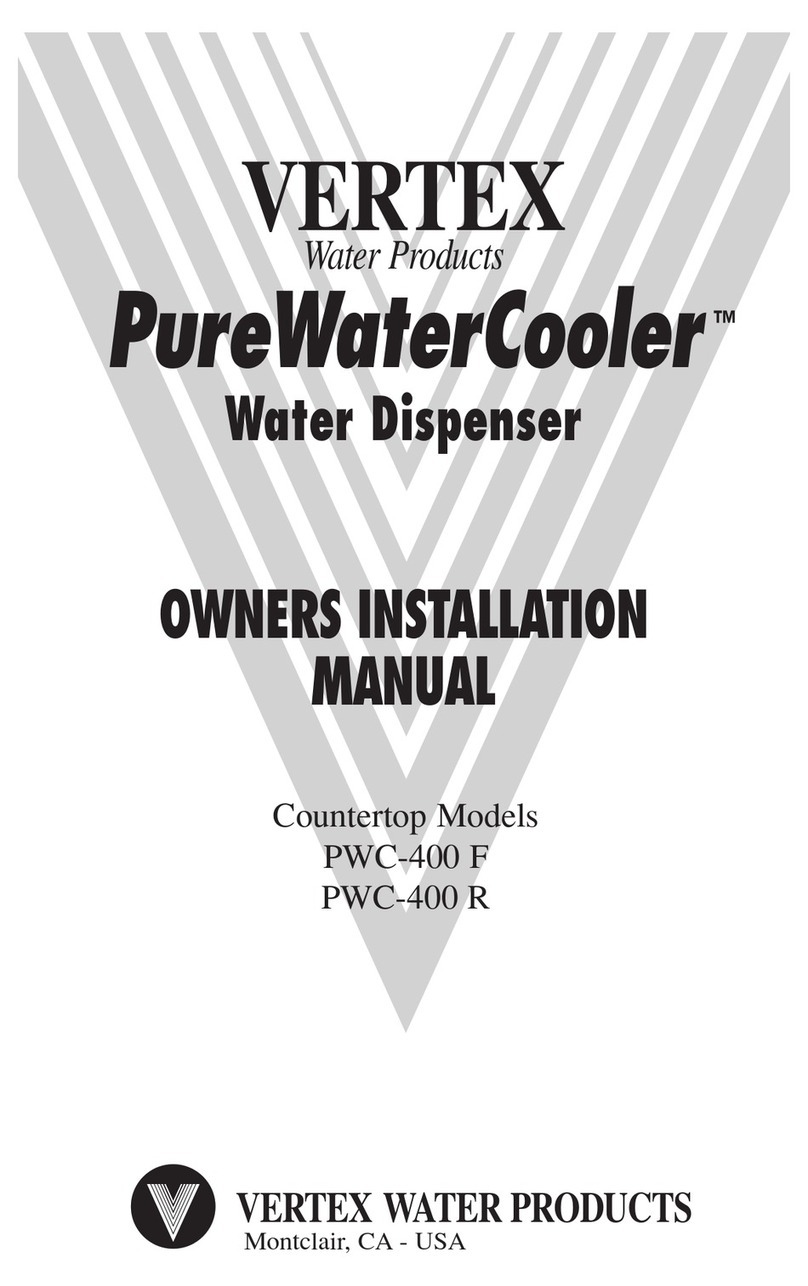
Vertex
Vertex PureWaterCooler PWC-400 F Owners & installation manual

BWT
BWT AQA drink Pro 20 CAS Installation and instruction manual
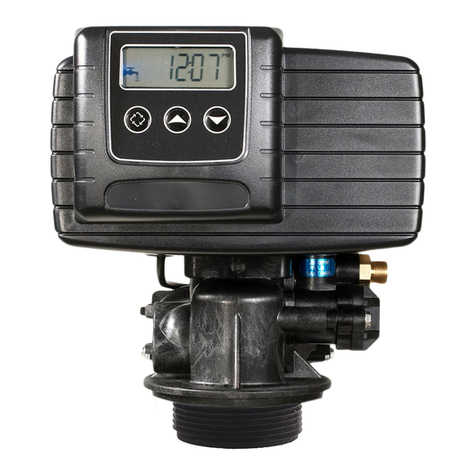
Pentair
Pentair FLECK 5600 SXT Installer manual
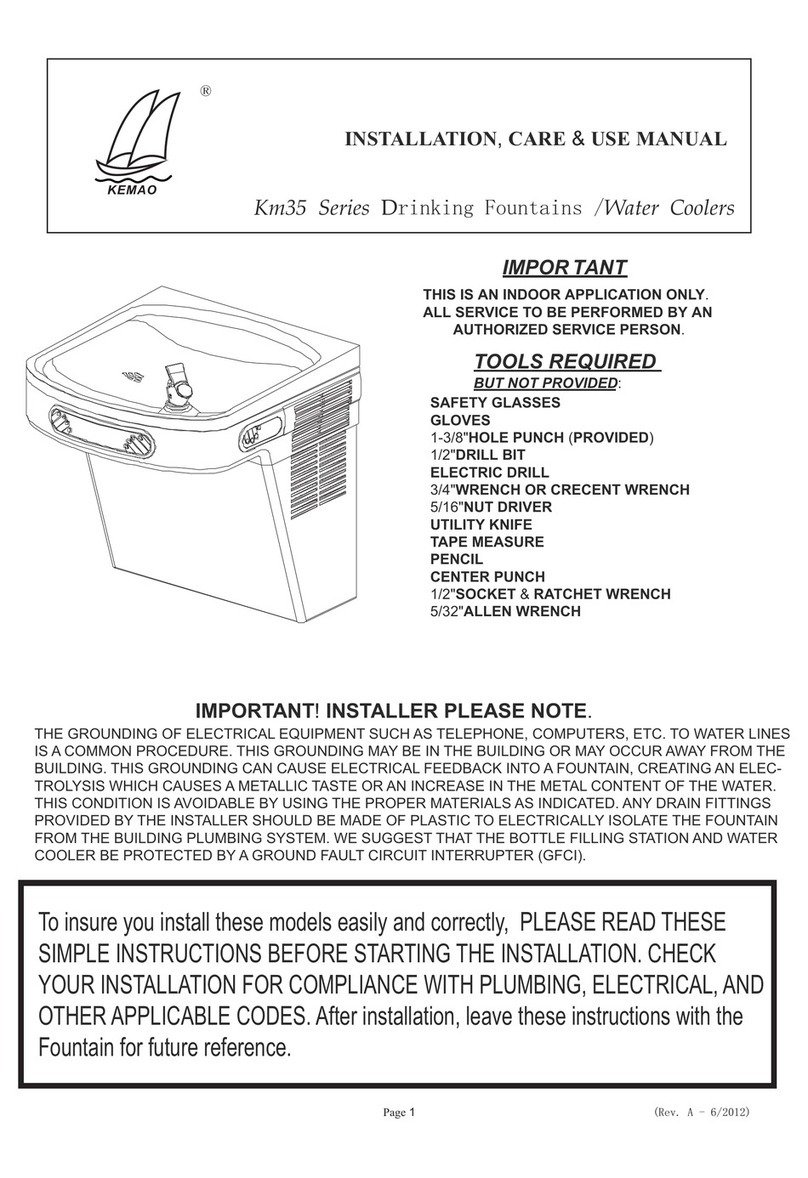
Kemao
Kemao KM35 Series Installation, care & use manual
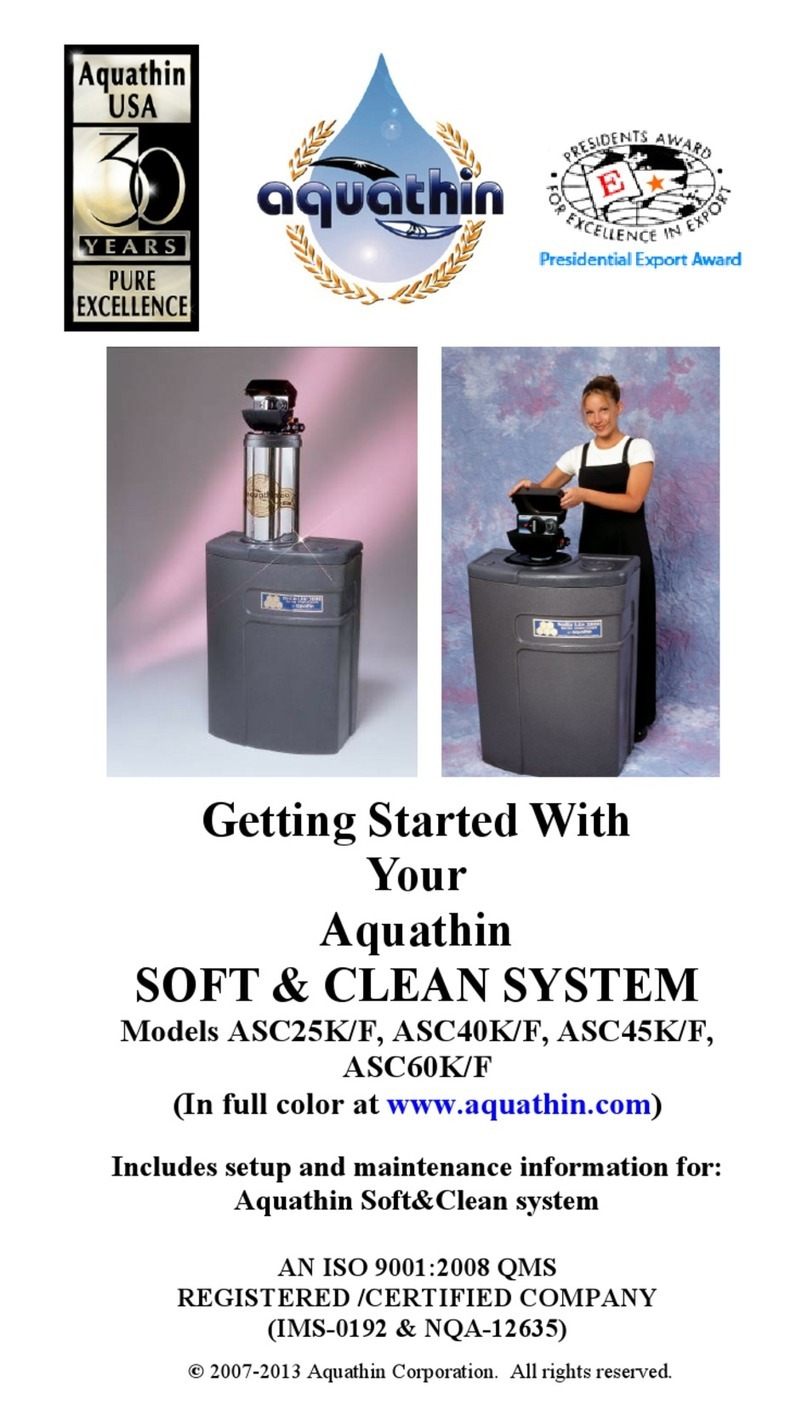
Aquathin
Aquathin ASC25K/F Getting started

Fetco
Fetco INNOTHERM L4-HD15 Users guide and operator instructions
